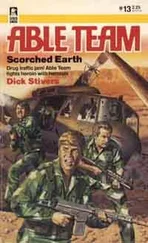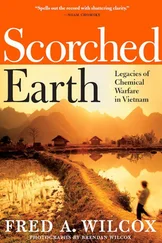Warren Murphy - Scorched Earth
Здесь есть возможность читать онлайн «Warren Murphy - Scorched Earth» весь текст электронной книги совершенно бесплатно (целиком полную версию без сокращений). В некоторых случаях можно слушать аудио, скачать через торрент в формате fb2 и присутствует краткое содержание. Жанр: Детективная фантастика, на английском языке. Описание произведения, (предисловие) а так же отзывы посетителей доступны на портале библиотеки ЛибКат.
- Название:Scorched Earth
- Автор:
- Жанр:
- Год:неизвестен
- ISBN:нет данных
- Рейтинг книги:3 / 5. Голосов: 1
-
Избранное:Добавить в избранное
- Отзывы:
-
Ваша оценка:
- 60
- 1
- 2
- 3
- 4
- 5
Scorched Earth: краткое содержание, описание и аннотация
Предлагаем к чтению аннотацию, описание, краткое содержание или предисловие (зависит от того, что написал сам автор книги «Scorched Earth»). Если вы не нашли необходимую информацию о книге — напишите в комментариях, мы постараемся отыскать её.
Scorched Earth — читать онлайн бесплатно полную книгу (весь текст) целиком
Ниже представлен текст книги, разбитый по страницам. Система сохранения места последней прочитанной страницы, позволяет с удобством читать онлайн бесплатно книгу «Scorched Earth», без необходимости каждый раз заново искать на чём Вы остановились. Поставьте закладку, и сможете в любой момент перейти на страницу, на которой закончили чтение.
Интервал:
Закладка:
Destroyer 105: Scorched Earth
By Warren Murphy and Richard Sapir
Chapter 1
In the beginning, no one expected the BioBubble to burst.
Certainly not the national press, which hailed it as being in the vanguard of man's exploration of space-even though it wasn't part of the space program.
When the space program angle became old news, the press hailed it as the perfect tool for solving the global eco-crisis of the moment.
The eco-crisis of the moment changed from moment to moment, of course. Sometimes it changed from newspaper to news outlet.
On the same day, at opposite ends of the continental United States, the BioBubble-a three-acre honeycomb terrarium of thermopane glass supported by white-painted steel trusswork-was simultaneously hailed as the solution to the global-warming crisis and the jumping-off point for man's eventual relocation to a less polluted planet.
Thus claimed the New York Times and the San Francisco Chronicle, respectively.
After a while, the national press began seeing it differently. Even with the decline in readership and the spiraling cost of bulk newsprint eroding the page counts of most big-city dailies, the editors still had column incises to fill.
The first red glimmering of trouble came when to support the faltering project-no one at BioBubble Inc. would say why it was faltering, just that it was-the facility was opened to tourists. Only then was the first discouraging word heard.
"Tourists? Isn't the BioBubble hermetically sealed? With airlocks?" asked a reporter at an outdoor news conference at the BioBubble site with the eroded redsandstone hills of Dodona, Arizona, shimmering in the background. The spot had been chosen for its resemblance to the landscape of Mars, according to the earliest press releases.
"Yes. To simulate every ecosystem on our fragile planet," said the director of information for BioBubble Inc., Amos Bulla.
"If you let in tourists, won't that destroy the BioBubble's eco-integrity?" a second reporter pressed.
"Tourists will not be allowed in. Only to look in. Think of it as a zoo with people on both sides of the bars."
"What if someone throws a brick?"
"The glass is tempered and bulletproof. But no one would be so malicious," Bulla said sanctimoniously.
In truth, no one was. Unless one counted the press and their figurative cast stones called factoids.
There was a spate of editorials criticizing the project for stooping to the level of a scientific Disneyland. But another round of editorials from rival papers, insisting that scientific research needed to hack out uncleared paths, put a temporary halt to that line of criticism.
Then a Japanese tourist with a Nikon and a roll of Fuji Super D Plus film shot the half-chewed pizza crust sticking out from the compost heap on the other side of the sealed glass-and-steel honeycomb habitat.
He sold the shot to the National Enquirer for sixty thousand dollars, and the Enquirer ran it on the front page, with the headline BioBobble Revealed. Because the Enquirer was now a chief news source for the national press, the Boston Globe took it seriously and sent one of its photojournalists to investigate.
"The photos clearly showed a pizza crust in the compost heap," the journalist argued.
"I agree," Amos Bulla said forthrightly. "But not our compost heap."
"The photo definitely showed white-painted steel trusswork in the foreground."
"A clever fake. The BioBubble has been sealed for over a year now. All the food is grown organically, then recycled. There is no pizza being baked or grown in the BioBubble habitat."
"Then why did the Enquirer pay a Japanese tourist sixty grand for a snapshot?"
"To sell newspapers. Just like you're doing," retorted the director of information for BioBubble Inc.
After the pizza-crust crisis blew over, things settled down for a while. And so did publicity. With publicity off, the tourist flow dropped to a lazy, sporadic trickle.
"We need to pump up the volume on this thing," said the financier of the project by long-distance telephone.
"Last time, the whole thing was almost blown out of the water," Bulla told him. When not dealing with the press, he functioned as project director-a position neither demanding nor critical, inasmuch as the facility, once sealed, was supposed to be self-sustaining.
"Whose fault was that?"
"That won't happen again. I laid down the law. Next time we sneak in pizza, everybody eats their crust, too. We can't afford another PR problem."
"Maybe we can manufacture a crisis."
"What kind of crisis?" asked Bulla guardedly, thinking I'm the front man so I'm the fall guy if anything goes wrong.
"An eco-crisis. What else?"
A solemn press release was duly issued, alerting the nation and the universe at large that the BioBubble, the self-sustaining greenhouse that was itself a miniature Mother Earth, was mysteriously, inescapably losing oxygen.
"This may in some way mirror the loss of greenhouse gases our dear Mother Earth is currently experiencing," Bulla announced.
This was said at a press conference at the Dodona, Arizona, site of the BioBubble construct with the hot sun making the Dome resemble an otherworldly gem.
The press was there in substantial numbers. It was a slow news day.
"Do you have any reason to suspect leakage?" Bulla was asked.
"BioBubble integrity stands one hundred percent. There is some atmo imbalance occurring within the habitat. Or one of the ecosystems."
Someone wondered if there was excess methane in the air.
"As a matter of fact, that is one of the rising gases. Why do you ask?"
"Methane is released through intestinal gas. There's a theory that bovine methane emissions are responsible for the ozone-layer problem," said the stringer from Mother Jones.
"There are only a dozen cows in the BioBubble."
"People fart, too. Especially eco-pioneers living off beans and tofu."
This was said in all seriousness, but the assembled press rippled in raucous laughter.
The director of BioBubble information wasn't amused and did not join in the merriment.
"Methane is only one of the problematic ascendant gases," he added. "Nitrogen is up, too. As is carbon dioxide."
"Will you pump in fresh oxygen?"
"Absolutely not," Bulla said firmly. "BioBubble seals must remain intact until the current test period is over. Otherwise, the experiment will be contaminated, and we must start over."
"How about sabotage?"
"Impossible. Who in their right mind would want to sabotage the salvation of all mankind? It would constitute mass suicide for Spaceship Earth."
Because this made a great soundbite, no one questioned Amos Bulla further. They rushed to beat each other to the air or in print with it.
The story made the back pages, and the press and public forgot about the BioBubble until the next crisis: another photograph showing portable tanks pumping oxygen into the supposedly airtight dome.
This time it was a National Enquirer photographer assigned to the BioBubble beat who broke the story. It turned out their first story had raised circulation thirty thousand copies. The Enquirer wanted to hold on to their readers and their quarters.
When the Enquirer broke the oxygen story, the national press jumped on it with all four feet.
Director of Information Amos Bulla fielded new questions like a man before a firing squad dodging bullets. Badly and not at all. His neck kept jerking.
"Why wasn't this oxygen infusion announced?" he was asked.
"Our last announcement was barely covered by you people. We concluded there was no press interest."
"What about the public's right to know?"
"They know now. We are hiding nothing." Bulla spread his meaty palms in a gesture of abject innocence. Every camera caught the slick sheen on his perspiration-drenched palms.
Читать дальшеИнтервал:
Закладка:
Похожие книги на «Scorched Earth»
Представляем Вашему вниманию похожие книги на «Scorched Earth» списком для выбора. Мы отобрали схожую по названию и смыслу литературу в надежде предоставить читателям больше вариантов отыскать новые, интересные, ещё непрочитанные произведения.
Обсуждение, отзывы о книге «Scorched Earth» и просто собственные мнения читателей. Оставьте ваши комментарии, напишите, что Вы думаете о произведении, его смысле или главных героях. Укажите что конкретно понравилось, а что нет, и почему Вы так считаете.


